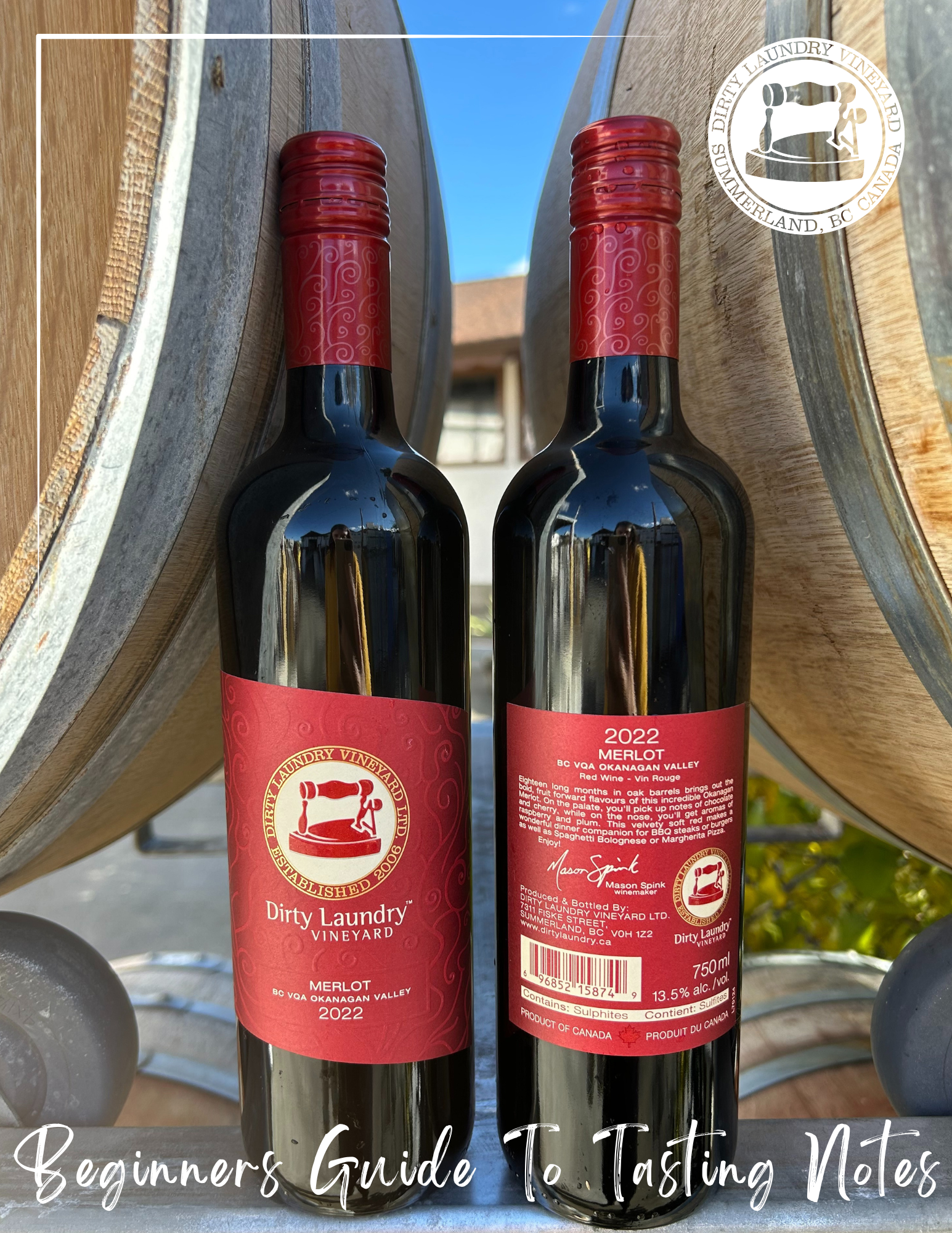Decoding Wine Tasting Notes: A Beginner’s Guide

When you pick up a bottle of wine and read its tasting notes, it can sometimes feel like you're deciphering another language. Terms like "oak," "tannin," or "minerality" may seem complex, but decoding wine tasting notes is easier than you think!
Simply put, tasting notes are the language of wine used by sommeliers, enthusiasts, and winemakers alike to communicate the nuanced flavours, aromas, and textures found in a bottle of wine. Understanding tasting notes can enhance your wine experience and help you discover what you enjoy most.
The Four Main Aspects of Wine Tasting Notes
Wine tasting notes usually focus on four key elements: Aromas, Flavours, Mouthfeel, and Finish. When reading a wine’s tasting notes, remember that they usually follow in the same order that you would taste wine: Sniff (the aromas), sip (the flavours), swirl (the mouthfeel) and swallow (the finish). Let’s take a look at each of these elements of the tasting notes in more detail:
1. Aromas (The Nose)
The first impression you get from a wine often comes from its aroma. Smell contributes significantly to our overall tasting experience, and wines can have incredibly complex aromas. These aromas—usually the first to be mentioned in the tasting notes—can be grouped into three categories:
- Primary Aromas: These come directly from the grapes themselves and tend to be associated with fruit, flowers, and herbs.
Fruit aromas: Wine aromas are often referred to in the tasting notes as either red or black fruit-driven—think cherries, raspberries, blackberries— for red wines or citrus and tropical fruit-forward like lemon, pineapple, melon for white wines.
Floral aromas: Certain wines give off scents of flowers like rose, violet, or honeysuckle, especially in aromatic white wines like Gewürztraminer.
Herbal aromas: Notes like fresh-cut grass, mint, or green bell pepper often appear in wines like Sauvignon Blanc or Cabernet Franc.
- Secondary Aromas: These are created during the winemaking process, especially through fermentation. Common secondary aromas that you would often see in tasting notes include butter (from malolactic fermentation), yeast, or bread-like scents (from the use of lees). You can learn more about these terms in our last blog post.
- Tertiary Aromas: These develop during aging, either in the bottle or in oak barrels. You’ll encounter notes like tobacco, leather, vanilla, cinnamon, clove, or earthy aromas such as mushroom or forest floor in wines that have been aged for longer. Some grape varieties also naturally give off hints of pepper or anise.
2. Flavours (The Palate)
Flavours are what you taste after you take your first sip. These often overlap with aromas, but they also reveal new layers of complexity.
- Fruit Flavours: The fruit flavours you would taste are similar to the fruit aromas mentioned above. Red or black fruit flavours for red wines, and citrus or tropical flavours for whites.
- Earthiness: Some wines express “earthy” flavours like wet stones, mushrooms, or soil. Wines from old-world regions like Burgundy or Rioja are famous for their earthiness. Our Bordello tasting notes observe an earthy note of cedar!
- Spice: Many wines offer subtle hints of spice or herbs, which can come from the grape itself or oak aging. Think black pepper in a Syrah.
- Oak Influence: Wines aged in oak barrels often have flavours of vanilla, caramel, or even coconut, giving them richness. You’ll see notes like "toasty" or "buttery" in wines like our Reserve Chardonnay.
- Minerality: This term refers to the sensation of tasting something clean and crisp, like chalk or wet stone. You often find this in white wines like Riesling..
3. Mouthfeel (Body, Acidity, Tannins, and Alcohol)
The texture of a wine can greatly influence how it’s perceived. ‘Mouthfeel’ in the wine tasting notes refers to the sensations felt in your mouth as you drink, and several key elements contribute to this:
- Body: The weight or "heaviness" of a wine. Wines can be light-bodied (like Pinot Grigio), medium-bodied (like Merlot), or full-bodied (like Cabernet Sauvignon).
- Acidity: Wines with high acidity feel crisp and refreshing, like biting into a tart green apple. You often see "zesty" or "bright" acidity in the tasting notes for white wines like Riesling or Sauvignon Blanc
- Tannins: Tannins are compounds found in grape skins and seeds, and are responsible for the drying sensation in your mouth after you sip a red wine, similar to the feeling you get from black tea. Red wines, especially from grape varieties like Cabernet Sauvignon tend to be tannic, offering a firm structure.
- Alcohol: Alcohol adds warmth and weight to the wine. A higher alcohol wine will feel fuller and warmer on the palate, while lower alcohol wines will feel lighter. Alcohol also plays a role in balancing sweetness and acidity, so in tasting notes phrases like "balanced" are used when the alcohol doesn’t overpower the wine’s other elements.
4. The Finish (Lingering Sensations/Taste).
The finish is a crucial aspect of a wine's overall quality and complexity. A good finish will leave a lasting impression, with flavours evolving or staying consistent. A few ways to describe the finish include:
- Length: The duration the flavours last. A long finish indicates a wine of higher quality, while a short finish suggests a simpler wine.
- Flavours: The flavours you taste at the end. It could be fruit, oak, spice, earth, or even a combination of these.
- Balance: Whether the finish feels harmonious or if one component (like acidity or alcohol) overpowers the others.
- Clean or Lingering: A clean finish means the flavours dissipate quickly and neatly, while a lingering finish allows the flavours to stay and evolve.
The finish helps to define the overall experience of the wine and can often be a sign of its complexity and craftsmanship.
Breaking Down Tasting Note Examples
To better understand a wine tasting note, let’s break down a couple of examples. In most cases, the tasting notes follow a similar pattern.
Tasting notes for Dirty Laundry’s
2020 Bordello:
- Nose: In this medium/full-bodied blend, you will find aromas of black currant, brandied cherries, fig, black cherry, and an earthy note of cedar.
- Palate: This juicy palate is full of flavours of plum, raspberry, cedar, star anise and sour cherry.
- Body: You will find this wine very approachable with medium tannins…
- Finish: …and a beautiful spice note on the finish.
In another example from our
2022 Cabernet Merlot, you can see the tasting notes follow the same pattern.
- Nose: On the nose you will find raspberry, rosemary and hints of chocolate.
- Palate: The palate boasts of cherry, cedar and slight hints of tobacco.
- Body: This bone-dry Cab Merlot has a big but balanced tannin structure with ripe raspberry mid-palate…
- Finish: …and a hint of pepper on the finish.
And finally, here is an example from the notes of Dirty Laundry’s
2023 Pinot Gris:
- Nose: On the nose you will find aromas of pear, and green apple.
- Palete: In this medium bodied wine you will find enjoyable flavours of green apple, nectarine, and slight herbal notes mid palate.
- Body: This wine is well balanced with a beautiful acidity…
- Finish:…and a crisp finish.
Quick Guide to Common Tasting Note Terms
- Bright: High acidity, fresh, and zesty.
- Buttery: Smooth and creamy texture, often from oak aging.
- Crisp: High acidity, refreshing.
- Earthy: Flavours or aromas reminiscent of soil, mushrooms, or wet leaves.
- Floral: Notes of flowers like rose or jasmine.
- Full-bodied: Heavier wine, usually with more alcohol or richness.
- Jammy: Rich, sweet fruit flavours (common in warm-climate red wines).
- Minerality: Flavours that evoke wet stones, chalk, or seashells.
- Oaky: Vanilla, toast, or smoky flavours from aging in oak barrels.
- Smooth: Low tannins, soft texture.
- Tannic: High tannins, drying sensation in your mouth.
Tasting Notes and Pairing Wine
Once you understand wine tasting notes, you can also use them to guide wine pairings. For example:
- Citrusy and herbaceous white wines like Sauvignon Blanc pair well with lighter dishes such as salads, seafood, or goat cheese.
- Rich and full-bodied reds like Cabernet Sauvignon are perfect with hearty dishes like steak, lamb, or aged cheeses.
- Fruity and light reds like Pinot Noir complement dishes like roast chicken, salmon, or earthy mushrooms.
Conclusion: Uncovering the Story in Every Sip
Wine tasting notes are more than just descriptions; they are a reflection of the wine’s journey from vine to glass. By understanding the various elements in tasting notes—aromas, flavours, mouthfeel and finish—you can gain a deeper appreciation for the art of wine. When you see phrases like “zesty acidity” or “blackberry notes with a peppery finish,” you'll know exactly what to expect from your glass.
So, next time you open a bottle, take a moment to notice the complexities and create your own tasting notes. It’s a rewarding way to enhance your wine knowledge and enjoy the experience of wine to the fullest.

